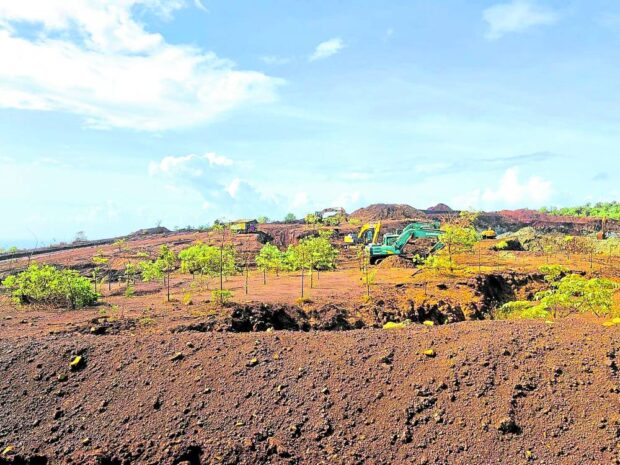Study mining impact on Homonhon – bishop

BALD MOUNTAIN | Operators of heavy equipment work at a section of Homonhon Island in Guiuan town, Eastern Samar, where mining operations are being conducted as shown in this photo taken on April 10, 2023. (Photo courtesy of ESTE NEWS)
TACLOBAN CITY, Leyte, Philippines — Bishop Crispin Varquez of the Diocese of Borongan has raised concerns over “escalated mining operations” on the historic island of Homonhon off the town of Guiuan in Eastern Samar province.
Varquez called on government leaders and concerned government agencies to take action on the matter to protect the resources of Homonhon, where the Spanish expedition led by Portuguese explorer Ferdinand Magellan landed on March 16, 1521, which eventually led to the Christianization of the Philippines.
According Varquez, there are four active mining companies extracting chromite and nickel on the island, whose “immediate and negative effects on the communities and the natural environment are very alarming.”
“We are very much disturbed by the escalated mining operations in our beloved historical island of Homonhon. I am appealing to authorities to carefully study the mining projects in the island to ensure that these will not have devastating effects on the environment and the local residents,” the prelate said in an April 11 statement.
He added: “We call on our government leaders and concerned agencies to take action on this matter and to consider primarily the preservation, safety, and welfare of the affected areas and its residents.”
Preserving history
The 20-kilometer long island, which is known for its vast deposits of nickel and chromite, has been grappling with open-pit mining since the 1990s, which continued to this day amid objection from many of the island’s 4,413 population and the diocese.
However, Eastern Samar Gov. Ben Evardone had said that he was not against mining activities on the island. Instead, he would want the miners to be responsible and to ensure that the environment and Homonhon Island’s rich history would not be affected.
“I am not against mining. I am for responsible mining. I don’t want the bad practice of mining to erase the rich history of Homonhon,” he said in a speech he delivered during the commemoration of Magellan’s landing on the island held on March 23.
Evardone has been calling on the national government to grant the local governments hosting the mining operations on Homonhon a share of the excise tax collected from these companies, noting that in 2021 alone, these firms extracted 605,176 metric tons (MT) of nickel ore and 19,105 MT of chromite from the island.
According to Evardone, the four companies currently operating on Homonhon Island are Techiron Resources Inc.; Emir Mineral Resources Corp.; King Resources Mining Corp.; and Global Min-met Resources Inc., all of which started only sometime in early 2015.
Techiron, which extracts chromite in a 1,500-hectare area in Homonhon, was among the mining firms ordered closed in 2017 by then Environment Secretary Gina Lopez but has since resumed operation after the Department of Environment and Natural Resources (DENR) lifted the suspension of its mineral export permit in April 2020, according to a company profile in the DENR online library.
The other companies also operate with valid mineral ore export permits issued in 2022, based on the online central database of the Mines and Geosciences Bureau.
Residents of the island led by the environmental group “Save Homonhon” have been conducting sporadic protest activities to stop the mining operations in the locality.
The Diocese of Borongan, which has jurisdiction over the island’s Catholic population, has been in the forefront of the campaigns to preserve and protect the island’s biodiversity.
Environmental groups and Catholic priests had earlier appealed to authorities to stop the mining operations on Homonhon but to no avail.